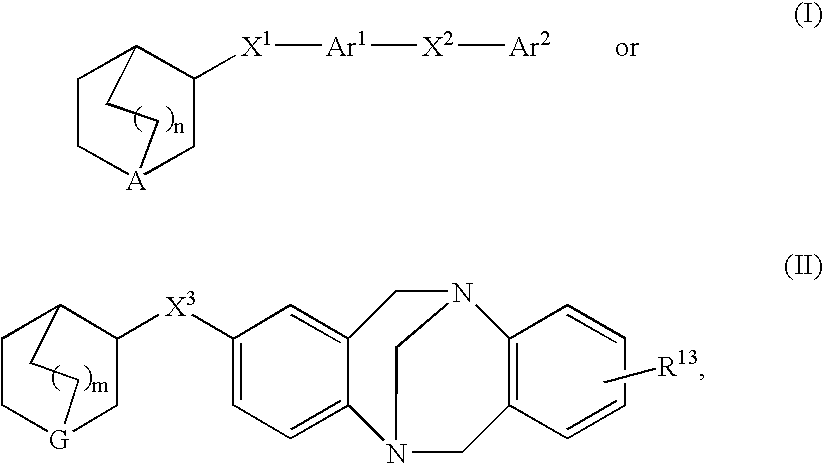3-Quinuclidinyl heteroatom bridged biaryl derivatives
a technology of biaryl derivatives and biaryls, which is applied in the field of 3quinuclidinyl heteroatom bridged biaryl derivatives, can solve the problems that not all the effects mediated by nicotine are desirabl
- Summary
- Abstract
- Description
- Claims
- Application Information
AI Technical Summary
Benefits of technology
Problems solved by technology
Method used
Image
Examples
reference example 1
(R)-3-quinuclidinol
[0217] (R)-3-Quinuclidinol hydrochloride (Aldrich, 20 g, 12.2 mmol) was treated with NaOH aqueous solution(20%, 50 mL) at ambient temperature for 10 min. It was then extracted with CHCl3 / PrOH (v. 10:1, 3×200 mL). The extracts were combine, washed with brine (50 mL) and dried over MgSO4. The drying agents were removed by filtration and the filtrates was concentrated under reduced pressure to give the title compound as white solid (15.5 g, yield, 99%). 1H NMR (300 MHz, MeOH-d4) δ 1.36-1.50 (m, 1H), 1.52-1.60 (m, 1H), 1.76-1.85 (m, 2H), 1.90-2.05 (m, 1H), 2.50-2.95(m, 5H), 3.10 (ddd, J=14.2, 8.4, 2.3 Hz, 1H), 3.82-3.88 (m, 1H) ppm. MS (DCl / NH3): m / z 128 (M+H)+.
reference example 2
(S)-3-quinuclidinol
Reference Example 2A
(R)-1-azabicyclo[2.2.2]oct-3-yl Benzoate (L) Tartrate
[0218] 1-Azabicyclo[2.2.2]oct-3-yl benzoate (Sigma, 17.9 g, 77.5 mmol) was treated with (L)-tartaric acid (Aldrich, 99% ee, 11.63 g, 77.5 mmol) in ethanol (80%, 222 mL) at ambient temperature for 1 week. The white solid was filtered off and dried under reduced pressure to provide 6.5 g of the title compound with ˜80% enantiomeric excess. Recrystallization from ethanol provided an enantiomeric excess of >98%. HPLC: chiralpak AD column 25 cm×4 mm ID; ethanol:hexanes 15:85; flow rate 1 mL / minute; uv 220 nM; Retention time 13.3 minutes. MS (DCl / NH3) m / z 232 (M+H)+.
reference example 2b
(R)-quinuclidin-3-ol
[0219] The product of Reference Example 2A (4.5 g, 11.8 mmol) in MeOH (40 mL) was treated with 15% aqueous NaOH (40 mL) and heated at 50 ° C. for 10 hours. The mixture was allowed to cool to room temperature, the MeOH was removed under reduced pressure, and the residue was extracted with chloroform (4×80 mL). The extracts were combined, dried over MgSO4 (anhydrous), filtered, and the filtrate was concentrated to give the title product as a white solid (1.35 g, yield, 90%). MS (DCl / NH3) m / z 128 (M+H)+.
PUM
 Login to View More
Login to View More Abstract
Description
Claims
Application Information
 Login to View More
Login to View More - R&D
- Intellectual Property
- Life Sciences
- Materials
- Tech Scout
- Unparalleled Data Quality
- Higher Quality Content
- 60% Fewer Hallucinations
Browse by: Latest US Patents, China's latest patents, Technical Efficacy Thesaurus, Application Domain, Technology Topic, Popular Technical Reports.
© 2025 PatSnap. All rights reserved.Legal|Privacy policy|Modern Slavery Act Transparency Statement|Sitemap|About US| Contact US: help@patsnap.com



